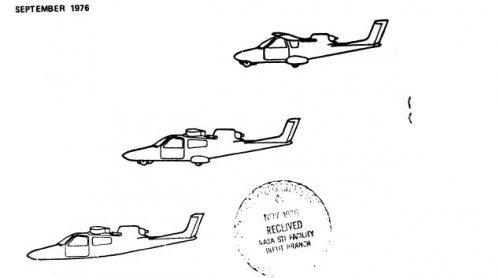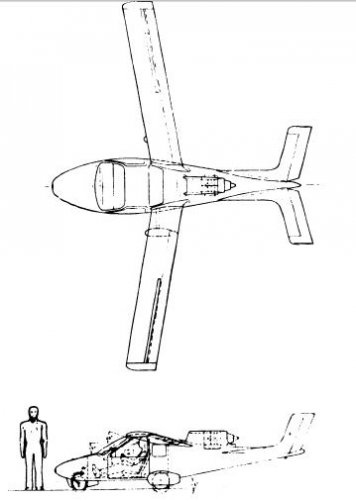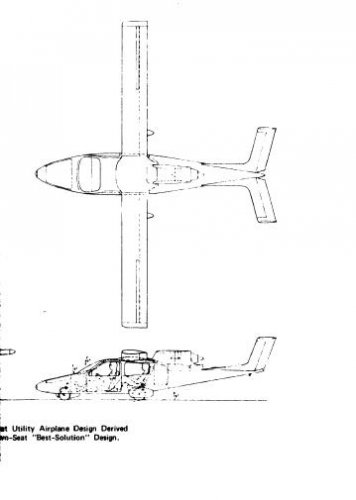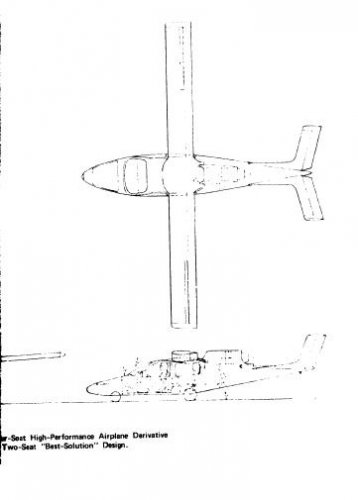You are using an out of date browser. It may not display this or other websites correctly.
You should upgrade or use an alternative browser.
You should upgrade or use an alternative browser.
A study for turbofan powered light aircraft
- Thread starter hesham
- Start date
Odd that they used constant-chord, high-aspect-ratio wings, but that would provide cost savings and docile stall behavior. I would be very interested in what kind of performance was predicted for this type of clean, simple, fixed gear personal jet, presumably without complex sysems. The designs remind me a bit of the Miles M.100 Student...

I am always reminded of the Miles M.20 fighter prototype, which used the same engine as the then-current Hurricane and Spitfire models and many parts from the Master trainer but still managed to outperform the Hurricane and come close to the Spitfire with fixed gear, manual flaps and double the fuel and ammunition load. As far as I know, no one has take the same approach to find out how fast and economical a single-engine light jet could be with the simplest systems possible.

I am always reminded of the Miles M.20 fighter prototype, which used the same engine as the then-current Hurricane and Spitfire models and many parts from the Master trainer but still managed to outperform the Hurricane and come close to the Spitfire with fixed gear, manual flaps and double the fuel and ammunition load. As far as I know, no one has take the same approach to find out how fast and economical a single-engine light jet could be with the simplest systems possible.
- Joined
- 11 March 2006
- Messages
- 8,632
- Reaction score
- 3,478
A bizjet with fixed landing gear probably would be a no-seller, I'm afraid. Owner
of bizjets seems not just to buy performance, but image, too. And if there really
would be a gain in performance, but no economical loss, compared to a turbo-prop,
I don't know. ???
of bizjets seems not just to buy performance, but image, too. And if there really
would be a gain in performance, but no economical loss, compared to a turbo-prop,
I don't know. ???
I just skimmed the report, but here are a few points from what I gleaned:
The three designs above are meant to be a family of related aircraft: two-seat trainer, four-seat utility and four-seat high-performance models with many common components. They are meant as turbofan alternatives to contemporary piston-engined aircraft, not competitors to business jets or turboprops. All are unpressurized.
The performance of the four-seat utility version, for example, is predicted at 150 mph at 10,000 feet for a range of 800 miles. Stall speed is a docile 55 mph with full flaps and take-off over a 50 ft obstacle only 2035 ft. All of those numbers are quite reasonable compared to a four-seat Piper, Mooney or Cessna single-piston-engine prop.
They are meant to use very low-power engines optimized for efficiency. We are talking about 216/404/469 lbf static thrust, respectively, for the three variants. The author rightly states that a turbofan designed for a single-engine, low-speed light aircraft is a very different beast than one for a high-performance jet. Efficiency and light weight are primary, while engine size is pretty much irrelevant, so a large centrifugal compressor, for example, is not a handcap.
The key to any such design, of course, is the availability of a reliable engine in that power range for reasonable cost. Williams (with NASA) worked on such very small turbofan engines in the past, but apparently decided that there wasn't any money to be made under about 900 lbf static thrust. I hope the Price Induction <http://www.price-induction.com/>DGEN engines actually come to market someday, which would allow manufacturers to test the waters. I'm not that optimistic about the prospects, however.
The three designs above are meant to be a family of related aircraft: two-seat trainer, four-seat utility and four-seat high-performance models with many common components. They are meant as turbofan alternatives to contemporary piston-engined aircraft, not competitors to business jets or turboprops. All are unpressurized.
The performance of the four-seat utility version, for example, is predicted at 150 mph at 10,000 feet for a range of 800 miles. Stall speed is a docile 55 mph with full flaps and take-off over a 50 ft obstacle only 2035 ft. All of those numbers are quite reasonable compared to a four-seat Piper, Mooney or Cessna single-piston-engine prop.
They are meant to use very low-power engines optimized for efficiency. We are talking about 216/404/469 lbf static thrust, respectively, for the three variants. The author rightly states that a turbofan designed for a single-engine, low-speed light aircraft is a very different beast than one for a high-performance jet. Efficiency and light weight are primary, while engine size is pretty much irrelevant, so a large centrifugal compressor, for example, is not a handcap.
The key to any such design, of course, is the availability of a reliable engine in that power range for reasonable cost. Williams (with NASA) worked on such very small turbofan engines in the past, but apparently decided that there wasn't any money to be made under about 900 lbf static thrust. I hope the Price Induction <http://www.price-induction.com/>DGEN engines actually come to market someday, which would allow manufacturers to test the waters. I'm not that optimistic about the prospects, however.
Similar threads
-
McDonnell V/STOL Aircraft with Vented Nozzle Concept
- Started by hesham
- Replies: 3
-
Vought Spanloader Flying-Wing Aircraft
- Started by hesham
- Replies: 2
-
A study for turbofan powered trainer aircraft of 1975
- Started by hesham
- Replies: 2
-
Rockwell Ejector Wing V/STOL Aircraft (report NR78H-91)
- Started by hesham
- Replies: 0
-
McDonnell Douglas 253 V/STOL Lift Fan Research Transport study
- Started by hesham
- Replies: 10




